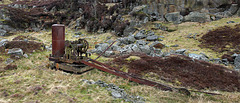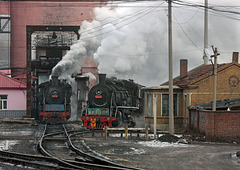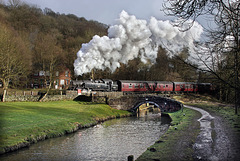tarboat's photos
A study in concrete
| |
|
Cowdale Quarry was opened by the New Buxton Lime Co c1901. The company was taken over by the Buxton Lime Firms in 1908 and shortly afterwards a bank of limekilns and a range of other buildings were constructed in concrete.
The quarry and works closed in 1956 but most of the structures remain. This is the entrance to the powerhouse with the Buxton Lime Firms initials and construction date of 1909.
St Peter's Church, Lower Withington
| |
|
|
St Peter's was built in late 1891 and consecrated in January 1892 by John Frances the Lord Bishop of Chester. The kit was probably supplied by Francis Norton & Co., Liverpool and delivered by rail to Chelford Station from whence it was carted on a wagon with horses by Mr Thomas Capper who was a gardener at Jodrell Hall under Sir Edward and Lady Stockton, who are thought to have given the site for the church.
In the 1920’s the vestry was extended and then in 1955-65 there were significant internal alterations including electric heaters to replace the coke boiler and an electric organ to replace the pedal bellows version. The rush seated chairs were replaced by pews and choir stalls from a bombed church in Birkenhead. The oil lamps were replaced with electric lights, leaving one original lamp as a reminder. A new wood block floor replaced the dry rot damaged original.
It is now a listed structure and remains in regular use.
Roman C & R
Ruabon District Marl Beds
'Industria Britannica'
| |
|
Adamantine was one of the trade names used by Charles Davison & Co Ltd, Ewloe Barn Brickworks, Buckley.
Obsidianite
| |
|
Obsidianite was one of the trade names used by Charles Davison & Co, Ewloe Barn Brickworks, Buckley. One of their catalogues states:
"There appears to be in the USA no product equivalent to Obsidianite manufactured by Charles Davison Co of Buckley, England (sic). The Adamantine quality can be used for chimney and flue building, and is of particular value in withstanding the action of acid laden gases. It is admirable for all kinds of foundation work, manhole linings and culverts. For places where wet conditions exist, Adamantine material is eminently suitable."
Royal Iris off Rock Ferry
| |
|
Mersey Ferry Royal Iris has just a few passengers for this trip to see the sights along the river. Seen from the mudflats below the derelict promenade at Rock Ferry. The serried ranks of terraced houses on the far shore ar at Dingle.
Fiddler's Ferry
Quarry plant
| |
|
Lhoist Hindlow quarry plant. A compact site with two limekilns and hydrating plant with associated crushing plant and hoppers. The former Buxton to Ashbourne railway runs in the foreground. It is now just a stub running to Dowlow Quarry.
A bit of morning glint
| |
|
Early morning service arriving at Sanjiazi junction on the Tiefa Coal Railway. It was scenes such as this that made it so worthwhile getting up early when on trips to China.
Steam crane
| |
|
The construction of the Stocks Reservoir was undertaken by the Fylde Water Board between 1921 and 1932. Stone for culvert arches and elsewhere in the works was obtained from Jumbles Quarry which was opened out high up above the reservoir site. A three foot gauge railway was constructed to move the stone and a standard gauge steam rail crane by Smith of Rodley was installed in the quarry. Stone for aggregate was first exposed here in September 1925 and larger stones were being quarried by March 1926.
On completion of the reservoir the quarry was abandoned and now, nearly seventy years later, the tracks and crane are still there. Apart from the cylinders which have been removed, the crane is remarkably intact, probably due to the remote and inaccessible location.
SYs at the pink mine
| |
|
Two-thirds of the locomotive fleet on the Lishu section of the Jixi Coal Railway is seen in front of the loading bunkers at the Pinggang Colliery.
Sykes limekiln
| |
|
Nineteenth century limekiln at the side of the Trough of Bowland road above Dunsop Bridge. The quarry that supplied the stone can be seen top left.
Just in time!
| |
|
During a day of cloud and squalls it had been difficult trying to get shots of the shareholder's special service on the Churnet Valley line. The sun finally made a fleeting appearance late in the afternoon as I waited at the traditional position where the railway crosses the Caldon Canal at Consal Forge. I could hear the train in the station and could see the clouds scudding towards the sun. Would the train come in time? As it was, 80072 accelerated across the bridge, I got my shot, and a few seconds later the sun disappeared for good.
Result! :-))
Gillan & Brown
| |
|
Loosely based upon the Injector Works of Davies and Metcalfe (Engineers to Railway and Industry), but with added railway connection, is this model of Gillan & Brown (Engineers to the World) seen at the Macclesfield Model Railway Exhibition this weekend.
Lady's Incline
| |
|
Standard gauge railways reached the Poynton Collieries in 1845 with the opening of a branch of the Manchester and Birmingham Railway from a junction with the Macclesfield line up to the Albert Pit. A coal yard was laid out on the east side the turnpike road level crossing from which landsales were made and trains assembled for dispatch onto the main line. By 1848, a further line was constructed from this yard to the Lord and Lady Pits at Hockley. It was known as the Lady's Incline and comprised a self-acting incline some 600 yards long at a gradient of 1 in 40, followed by some 400 yards at an easier inclination until Lord Pit was reached.
The self-acting incline continued in use until 1882 when it was converted to locomotive operation following the purchase of a tank locomotive from Walker Brothers of Wigan. When the collieries closed in 1935 the tracks were soon removed and the incline became a public footpath, well used by local people.
In 1984 the local council undertook improvements to the surface and during preparatory works the remains of the top wheelpit and rope guides for the self-acting incline were revealed. These were left in-situ and a course of bricks laid on top to represent the structures below the surface. This has survived well, as can be seen in this recent view looking down the incline across the wheelpit.
When times were better.
| |
|
Panorama of Redcar furnace and associated structures in June 2008 when business was good and recession was not in anyone's mind.
Washery bound
| |
|
Uphill trains run tender first on the Lishu system of the Jixi Coal Railway. As the sun falls low in the winter sky, SY 0951 trudges up with wooden hoppers filled with coal to be washed at the Pingang Colliery. It may have been a short train but the gradient is steep and the loco was working hard. The sound was wonderful!


















